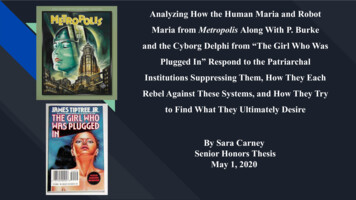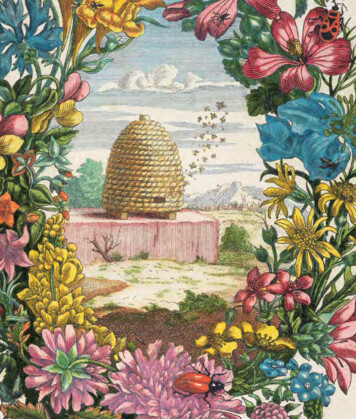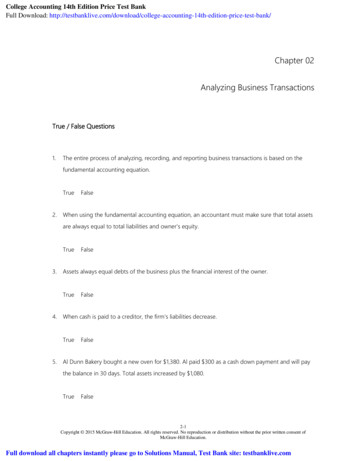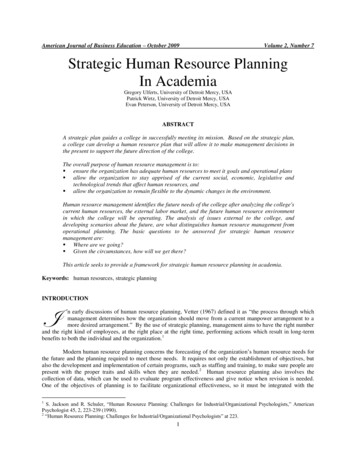
Transcription
Analyzing How the Human Maria and RobotMaria from Metropolis Along With P. Burkeand the Cyborg Delphi from “The Girl Who WasPlugged In” Respond to the PatriarchalInstitutions Suppressing Them, How They EachRebel Against These Systems, and How They Tryto Find What They Ultimately DesireBy Sara CarneySenior Honors ThesisMay 1, 2020
Human Maria andRobot MariaThe film Metropolis, directed by Fritz Lang, and theshort story, “The Girl Who Was Plugged In” by JamesTiptree Jr., display female characters whose identitiesare threatened by patriarchal institutions. Each of thesefemale characters (Metropolis’ human Maria and robotMaria and “The Girl Who Was Plugged In”’s P. Burkeand cyborg Delphi) are all used as pawns to increasethe greed of wealthy and corrupt businesses, losingthemselves in the process. However, the women rebelagainst their oppressors and try to achieve what theydesire. All four women attain or sometimes to fail toattain their autonomy in different ways. My SeniorHonors Thesis analyzes each woman’s character andhow they persevere and are determined to achieve theirown freedom from repression.P. BurkeandDelphi
Human Maria’s Determination for a Peaceful Rebellion: Wanting ToCreate Change Through Mediation Human Maria, in her own peaceful way, rebels against the upper class’ view of what isimportant just by the way she dresses and controls the room. For example, when the audience is first introduced to human Maria, she enters theEternal Gardens of the wealthy, appearing with multiple children. These children express their love toward the human Maria by being near her, reachingout to hold onto her clothing, wanting her guidance. She wears a plain, simple white dress that stands out among the darker colored clothingthe children are wearing. In this scene, the human Maria stands out because, even withher plain style, she somehow exudes an elegant and classy nature. Maria’s entrance is bold in that the wealthy who stand before her become confused:“these two groups have so little contact that they seem almost ignorant of each others’existence, as if embodying our inability or reluctance to interrogate the technologicalconditions on which our lives increasingly depend” (163). Maria tells the children that the wealthy, “are your brothers!” Her goal is to unify thepeople instead of having social stratification and inequality.
Human Maria’s Determination for a Peaceful Rebellion: Wanting ToCreate Change Through Mediation The human Maria preaches against the suffering thatthe workers have to experience laboring for the richbusiness magnates, including Joh Fredersen The workers are literally being eaten alive by Joh’sShe then states her famous phrase, giving the workershope for a solution: “Head and Hands need aMediator. The Mediator between Head and Handsmust be the Heart.” greed, laboring endlessly, and feelingwho, “will alleviate the workers’condition bytortured and trapped in this system serving as the heart that will harmoniouslyHuman Maria is seen as a symbol of light for theunite head (Joh Fredersen) and hands (theworkers, especially in the catacombs scene Reflecting religious imagery, the human Marialaborers)” (Donahue 211). represents tranquility and resilience, encompassingHuman Maria alludes to their hardships by statingthat, “One man’s hymns of praise became otherscurse.”Maria states that the only way to solve thisproblem is by having a mediator, who willthe virtues of trust and faith Here, the human Maria discusses a personhelp the two groups resolve this conflict. Her speech about the mediator is verycomforting for the men, giving them hopeand reassurance about a safer future.
Joh Fredersen and Rotwang’s Patriarchal Control OverHuman Maria, Shaping Her Image Into the Robot MariaThey Thought They Could Control During human Maria’s speech, Joh Fredersen, the wealthy boss of the workers,as well asthe outcast inventor Rotwang, spy on the meeting in the catacombs. Joh Fredersen immediately sees human Maria as a threat to his power, rallyingthe workers together. However, an overthrow of Joh’s power is the complete opposite of what humanMaria had intended. Joh misreads her message and instead views her as a sourceof revolution for his workers. In order to remain in control, Joh orders Rotwang, Metropolis’ outcast inventor,to, “Give the Machine-Man the likeness of the girl. I shall sow discord betweenthem and her! I shall destroy their belief in this woman!” Joh sees how the workers respond to Maria and wants that relationship to besevered completely so that nothing will threaten his reign at the top ofMetropolis.
Joh Fredersen and Rotwang’s Patriarchal Control Over HumanMaria, Shaping Her Image Into the Robot Maria They Thought TheyCould Control Human Maria falls right into Rotwang’s trap after heworking together to control and recreate the image forstraight into his strange homerobot MariaAfter Rotwang captures Maria, she loses the cloth sheAfter the experiment has been completed, theMachine Man’s actual form is no longerFreder’s discovery of the lost cloth reveals Maria’svisible. Rather, a clone of Maria has taken his place. Althoughresist against her abductionhuman Maria and robot Maria are supposed to beShortly after, the audience sees an unconscious Mariaidentical, viewer can see significant details thatin Rotwang’s machine, ready to become programmeddisplay their differences. The set-up of Maria connected to all the wiresemphasizes the idea that her image is being sacrificed wore during the catacombs’ meeting.to be the robot. There are multiple machines in Rotwang’s laboratorychases her from the darkness of the catacombs andloss of control; she is being restricted in her power to Robot Maria has darker make-up around her eyes andlips, indicating that there is an evil entity inside. In close-ups, the audience sees that she also wears ato this machine and she is under Rotwang’s mercy.sinister and knowing smile, ready to cause destructionShe has lost her gift of free will and is now an objectat any given chance.
Joh Fredersen and Rotwang’s The character robot Maria is at first conceived as acollaboration between Joh Fredersen and thePatriarchal Control Over HumanMaria, Shaping Her Image Into theinventor Rotwang. Joh Fredersen fears the possibility of arevolution; therefore, he commands Rotwang to,Robot Maria They Thought TheyCould Control“Give the Machine-Man the likeness of the girl. However, Rotwang has ulterior motives, decidingto trick Joh and use the machine to destroy him andhis son. Rotwang chooses to do this as revengeagainst Joh; he loved Joh’s wife Hel, who had diedgiving birth to Freder. Thus, robot Maria is programmed with Rotwang’scontempt and bitterness. Robot Maria’s personality is again beingmanipulated by a male figure, leaving her nochance to determine her own identity.
Robot Maria’s Dance, Preaching, charge, robot Maria’s fate had been controlled by twoand True Nature Emerging from theMale Gaze: Forming Her Own EvilWith the two forces of Joh Fredersen and Rotwang indominant male forces. Joh Fredersen wanted robot Maria to destroy thecharacter of human Maria because she was gainingIdentitymomentum with the workers Rotwang’s first review of robot Maria to Joh describedher as the, “most perfect and most obedient toolmankind has ever possessed.” The quality of obedience and perfection had alreadybeen prescribed for robot Maria. She was a corrupt machine under the control of the malegaze, following Joh Fredersen’s commands to, “visitthose in the depths, in order to destroy the work of thewoman in whose image you were created.” Lauren Nossett cited Andreas Huyssen’s assertion that,“the male desire to create life in Metropolis as thepursuit to master nature itself” (148).
Robot Maria’s Dance, Preaching, and True Nature Emerging from the Robot Maria’s dance is a complete display of the male gaze. BarbaraHales states that,“The evil Maria, dressed in a half-moon headdress with a lace capeand belly costume, mystically emerges out of a large smoking caldronMale Gaze: Forming Her Own Eviland onto the stage in Freder’s (Gustav Frolich) “Whore of Babylon”dream” (541)Identity The machine’s skimpy and scandalous clothing tantalizes the men. The film shows this, as Hales states, “by focusing the audience’s gazein a series of camera shots that cut from images of male faces to amontage of disembodied eyes” (541). They are practically salivating over her, giving into their lustfuldesires and tearing apart the best of friends. As Ruppert states, “Femininity, this sequence suggests, is constructedby male vision; female sexuality comes to life through male desire”(6). Her seductive dance moves reinforce the idea that she has become acommodity for these men to objectify. In this scene, robot Maria also symbolizes the practice of idolatry. The men are worshipping this person as if she is an idol. However, this practice leads to destruction, death, and disorder.
Robot Maria’s Dance, Preaching, and True Nature Emerging from theMale Gaze: Forming Her Own Evil Identity Joh Fredersen and Rotwang’s patriarchal influence extends further when Robot Maria begins to preach tothe workers in the catacombs. the Machines!” Yet, as she continues her speech, the viewer sees howthe robot is starting to form her own identity, separate trance-like wonder culminates in a high angle shot ofincite a rebellion against Joh, similar to Rotwang’s helpless men” (541). Her evil nature shows through the use of close-ups,where she becomes more excited and wild in her human Maria ever did. She uses her body movements more, leaning in to talkto the workers and squinting her eyes to emphasizeThrough this speech, she develops her own wickedpersonality, convincing the workers very easily toRobot Maria uses her physicality to express what shemeans, flailing her arms while speaking more thanThe men listen intensely to her speech, following herevery move.facial expressions. As Hales states, “the series of shot-reverse-shots inwhich Maria fosters unrest and the men listen inRobot Maria goes to the catacombs and begins toplan.Robot Maria persuades the workers to follow her,enticing them to begin a revolution.from the two men’s wishes. She shouts that the workers must, “Killcreate chaos. Minden reveals robot Maria’s true character, stating,“the pleasure, though real, is a lure and a deception”(349).
Robot Maria’s Dance, Preaching, and True Robot Maria’s has all of the city under her commandafter the workers rush out of thecatacombs. Once the riot has started in the Underground City,robot Maria continues her eccentric movements,Nature Emerging from the Male Gaze:Forming Her Own Evil Identity listen.encouraging both men and women to join the crowdsto kill the machines. weapons to break down the gates.“[become] an aggressive adversary, a subversive force supposed to obediently carry through.the robot further preaches her message to “Kill thein the insanity of it all.Robot Maria’s revolution is her rebellion against the male forceswho had suppressed and given commands that she wasThis behavior is seen in the town square where the theMachines!” and embraces this mob mentality, revelingThe citizens of the city are rushing and stampeding towards theelevators, their hands reaching out to one another and usingThe robot Maria, as Ruppert states, has nowunleashing repressed social energies” (6).The scene has become total chaos where robot Maria leads thecharge maniacally.destruction, ultimately a self-defeating strategy for theworkers” (7).Robot Maria leads the workers to the machines, standing out inher white dress among the darker and uniformed clothing.Ruppert asserts that robot Maria, “acts on her own asno one’s tool, [she] also excites violence andOvercome with rage and struggle, the workers and their wives Robot Maria eventually wanted to betray the men who havecreated her. By preaching to the workers and inciting a violentrevolution, robot Maria gets to watch in glee how the patriarchalinstitutions that were controlling her are beginning to
Robot Maria’s Dance, Preaching, and True Nature Emerging from theMale Gaze: Forming Her Own Evil Identity The workers, with robot Maria leading the way, demolish the Heart of everyone, including the workers’ children. yet, sheMachine and are so wrapped up in their joy for revolution that they dodoes not care because she is programmed to causenot realize the consequences of their actions. Robot Maria knew the results of smashing the Heart Machine, so sheflees up a flight of stairs in glee to join the upper classes and party. This specific scene shows that robot Maria has developed her ownconscious mind, knowing that the consequences of this decision could bedevastating but still choosing to pursue it anyway. violence and has no soul.Since they had wrecked the Heart Machine, the entire city where theirchildren lived would be flooded.The workers became robot Maria’s perfect victims as “in theirirrationality and unpredictability: they reach for violence not in order toprosecute their agenda, but to destroy their very own city, attacking it infury without even the assurance that their own children are safe”(Donahue 219).Robot Maria knows that she is endangering the lives With this scene, she has revealed her cruel and truenature.
How Robot Maria’s Reaction Towards Her Imminent Death ReflectsHer Win Over the System of Patriarchy Once the mob had grabbed robot Maria, declaring her ideologically, with her earlier speeches in the catacombs and in thea witch and wanting to burn her at the stake, robottown square.Maria was oddly elated. As Nossett states, the workers wanted to murder the, Fredersen, one of the men who had originally controlled herrestored” (160).actions.Dragged by the workers towards her imminent end,robot Maria is laughing hysterically, not expressing rebellion so far that, she has crushed Fredersen’s source of incomeShe shows no panic; instead, robot Maria continuesas well as the homes of thelaughing even while she is being tied to the stakethousands of workers living in the Underground City.amid the smoke and the flames. Robot Maria is expressing this joy at such a strangetime because she has realized that she has succeeded Thus, the workers had done all the physical work for her. Robot Maria’s laughing reflects that she has won, inciting the chaosthat took the patriarchal system completely out.in tearing down the patriarchal system. She had tricked the workers into smashing andbreaking the machines, their livelihoods; thus, theworkers had done all the physical work for her.Free from Joh’s and also Rotwang’s supervision, robot Maria takesthe robot Maria takes theany fear or retribution for her actions. She had purposefully eliminated any hope of patience for the arrivalof the Mediator, wanting immediate action to be taken against Joh“sexualized female robot.so that order can be Robot Maria destroyed patriarchy’s hold on the workers She had conquered convincing the workers to engage in wild maniaand accomplished sabotaging Joh Fredersen’s dominating businessand authority over her own, individual actions.
How Robot Maria’s Reaction Towards Her Imminent Death Reflects Her Win Over the System ofPatriarchyAs robot Maria is being burned at the stake, her true physical form isrevealed.In all of the chaos, the fire’s flames have caused robot Maria’s imageto disappear, “the fleshy, sexual female body of the robot isdestroyed to reveal the machine” (150). However, Joh Fredersen has known all along what robot Maria trulylooked like. This scene revealing robot Maria’s true form exposes how an objectthat Joh thought would keep him in power performed the completeopposite. She wanted to eliminate the patriarchal society completely, causingdestruction and inciting violence along the way. The uncovering of her actual physical form reflects how JohFredersen’s diabolical attempt to keep the workers compliantultimately failed. This invention results in the reverse outcome for Joh and endangershis entire livelihood, ruining everything. A ploy that was supposed to keep Joh Fredersen’s status on topcrumbled and left his patriarchal system in pieces, with “thedestruction [robot Maria had incited seeming] to exceed their effortsto control her” (171). Robot Maria, originally created and organized to suppress revolutionand promote patriarchy, overcame Joh’s expectations and lead to hisbusiness’ own downfall.
Similarly, this self-destruction of a patriarchal system is seen in Tiptree’s “The GirlWho Was Plugged In.” Through P. Burke and Delphi, the reader sees that the womenare used as GTX’s tool for promotion and fame. While, unlike the Marias, bothwomen, with P. Burke as Delphi’s brain, comply with the corporation’s control atfirst, they eventually want to chase after their own desires, as shown with their malegaze oriented romance with Paul. Unlike the Marias, they do not promote changingthe company’s patriarchal hierarchy; instead, they want to pursue their own individualneeds. In contrast, specifically to robot Maria, the women do notpurposefully incite chaos to take down patriarchy; P. Burke and Delphi have rebelledagainst their bosses’ wishes but to fulfill their longing to be with the man they love.
“The Girl Who Was Plugged In” - Why P. Burke Decided to Work Under the Control of aPatriarchal System- An Escape from the Pain of Her Real Life When first introduced to Tiptree’s main character, P. Burke, the narrator of theTherefore, when offered the job from GTX,short story paints a completely negative and cruel picture of her.P. Burke is finally talking to an actualTiptree’s narrator does not even allow the reader to know her name; rather, hehuman who is giving her attention,refers to P. Burke as, “One rotten girl in the city of the future” (43).something she was deprived of, and anThe very first details in the beginning of the short story indicate that P. Burke isopportunity to escape from her drearyan observer of human life, living as an outcast, wondering at the “gods” (theexistence.celebrities) in society who, “in a million years it’d never occur to her that her Stevenson explains further how P. Burke,gods might love her back” (43).“is a perfect subject for corporate controlThe narrator paints P. Burke’s distance from humanity even further stating, “thebecause she is not tied to her world throughadoration’s fading from her face.bonds of love or friendship” (95). That’s good, because now you can see she’s the ugly of the world. A tall monument to pituitary dystrophy. No surgeon would touch her. When shecontrol of GTX, she would be able tosmiles, her jaw--it’s half purple--almost bites her left eye out. She’s also quiteconnect to other people and feel true humanyoung, but who could care?” (44).emotion, something she was never able toThe narrator’s description of P. Burke is so dehumanizing, displaying that thisachieve before. young woman is devoid of any human connection. No one wants to help P. Burke Although P. Burke’s life would be under theP. Burke has no other connections to warnwith her physical deformities as, “the only response that her body elicits isher or advise her about working with thedisgust, which the narrator seizes every opportunity to emphasize” (Ferrandezcompany. It is her first opportunity toSan Miguel 37).escape and flee the awful experiences life
“The Girl Who Was Plugged In” - Why P. offers her the chance to interact with one of the gods saying, “I have a job for someoneBurke Decided to Work Under the Control of alike you.It’s hard work. If you did well you’d be meeting Breath [a god] and stars like that allPatriarchal System- An Escape from the Painof Her Real LifeP. Burke, while recovering from her suicide attempt, is visited by a GTX worker whothe time” (48). Now, this worker is actually talking to P. Burke, giving her actual human attention thatshe was always deprived of. When the worker offers P. Burke this opportunity to escape from her life, she isperplexed but intrigued However, the GTX worker does reflect the corporation’s restrictions immediately,stating that, “But it means you never see anybody you know again. Never, ever. You will be legally dead. Even thepolice won’t know. Do you want to try? (48). This conversation reflects that GTX’s activities are illegal, operating secretly in order to survive in the capitalist economy. P. Burke is given achance to decide whether she will choose this path and while the GTX worker repeatsthe conditions, Tiptree’s narrator reflects P. Burke’s thought process by having, in italics, “Show methe fire I walk through” (49). P. Burke voluntarily takes the opportunity the GTX worker offers because he is thefirst person treating her normally and respectfully, asking for her consent. However, P.Burke’s agreement leads her to having every aspect of her life controlled by thecompany.
P. Burke’s Female Identity is Split With the CyborgDelphi: How Both Women Respond At First to GTX’sP. Burke’s transformation to become Delphi is a long process, taking place,“five hundred feet underground near what used to be Carbondale, Pa” (48). Due to the sketchy location of GTX’s underground laboratory, the narratorindicates that the activities occurring are not supposed to be discovered byDemandsoutside forces; the corporation must keep it a secret. P. Burke is excited to take part in the experiment, wanting to leave herphysical body completely behind. The narrator describes that P. Burke is “Eager” to begin the transferal process,“butting jacks into sockets” and developing the five senses through “potentialpattern flickering over the electrochemical jelly between [the] ears.deliveredvia long circuits from your hands” (48-49). The reader sees her cyborg, named Delphi, counterpart’s physicalappearance, which is described as, “the darlingest girl child you’ve EVERseen” (48). Delphi’s body, as Stevenson states has, “its stereotyped feminine perfection,[allowing] her to escape from her old form and its largely negativeexperiences in the world” (95). She is referred to as a, “a porno for angels,” a “kitten,” an “elf,” and a “honeypot,” signifying that Delphi’s physical appearance correlates to traditionalstandards of beauty, allowing her to stand out and be noticed (Stevenson 97).However, Delphi is not a separate entity from P. Burke; rather, P. Burkeoperates as Delphi’s brain from a different host, connected to multiple circuitsand wires in, “a huge cabinet like a one-man sauna and a console for Joe,” aworker at GTX (48).
Delphi, the opposite of P. Burke, has beautiful physicalP. Burke’s Female Identity is Split With the Cyborg Delphi:characteristics, making the workers at GTX excited toHow Both Women Respond At First to GTX’s Demandswork with her while promoting the ideals of consumerism. Meanwhile, this official splitting of P. Burke’s femaletrue intentions with regards to her work. Delphi is going to live a wonderful, exciting life. She’s going to be a girl people watch. AndStevenson asserts that, “P. Burke is not aware of her ownshe’s going to be using fine products people will be glad to know about and helping themalformed and abused flesh” (98).good people who makeThe narrator even echoes this sentiment, reducing her to,them” (52).“the forgotten hulk in the sauna next door,” the GTX's San Miguel notes that P. Burke’s connection toFor example, Delphi will influence the public on stylish trends and activities,“demonstrating the “best” clothing to wear, activities to pursue, and products to use”new pawn to be taken advantage of. Mr. Cantle, a GTX employee, addresses Delphi and P. Burke withdirections on how to carry themselves in a nice but condescending tone stating, “littleidentity leads her to disregard her own body. There are multiple incidences where GTX controls Delphi’s character by lying about their(Stevenson 97). Delphi, assisted by P. Burke’s brain will also, “attend parties, go to fashionable places andmeet other celebrities while using the products GTX wants them to promote” (Ferrandezlife-support is, “[to] better fulfill the economicSan Miguel 36).aspirations of her corporate owners” (38). Although the GTX do not degrade or ignore P. Burke,however, there is also an underlying message in his direction, implying that the women’smain function will be to help GTX access the profit as much as possible.they only want her to become Delphi in order to makemoney and gain prestige for the company.Here, this GTX employee is stating what Delphi and P. Burke will work on; The narrator defining P. Burke as a “waldo,” a remote manipulator used for puppets, showsthe GTX’s outlook on P. Burke (54). Throughout “The Girl Who Was Plugged In,” the readernotices that Delphi becomes a famous face for productplacement, even though that practice has been outlawedin this society. She is being exploited, losing herself willingly, to carry out the deeds of the company. According to San Miguel, “[P. Burke’s] life is to be determined by biopolitical technologiesof power that are market-oriented and seek to conserve life through its regulation in order toguarantee that the individual follows a pattern of consumption” (38).
P. Burke’s Female Identity is Split With the Tiptree’s narrator even discerns that P. Burke is beingprogrammed into the system constantly, so much soCyborg Delphi: How Both Women Respond Atthat, “she hasn’t spoken through her own mouth forFirst to GTX’s Demandsmonths” (61). As Jonas Neldner states, “the narrative emphasizes theconstructed ideal of femininity, which prompts P. Burketo disembody from her real body and to rembodyultimately as Delphi in order to fit in” (14). P. Burke is in love with her new robotic alter ego, somuch so that she does not realize she is sacrificing herhuman life for the sake of a company. She is losing herself physically but is content, baskingin the human connection she never received earlier inlife. As Stevenson concludes, “for P. Burke, the only real lifeis her fake one” (95).
P. Burke and Delphi Rebel Against GTX, GivingInto Their Own Free Will and Desires Throughout, “The Girl Who Was Plugged In,” there were several instances where both Delphi and P. Burke began to distance fromGTX’s control. Specifically, with the latter character, P. Burke wanted to become Delphi completely, forgetting her own existence. She wanted to merge with Delphi somehow, leaving behind her human body and joining the robotic one. Secretly at times, Delphi would experience moments of cognition of her own free will. Tiptree’s narrator mentions this detail, emphasizing how, “But now and again Delphi all by herself smiles a bit or stirs in her “sleep.” Once she breathed a sound: “Yes” (60). Even Delphi’s lover, Paul, states that, “she called his name in her sleep” (70).These instances when Delphi gains cognitive control of her mind without P. Burke being wired up and connected to her are majorevents. The narrator even mentions that, “if the bushy Dr. Tesla had heard that single syllable [from Delphi], his bush would haveturned snow white. Because Delphi is TURNED OFF” (60). This one sentence stresses the importance of GTX’s control over Delphi and P. Burke. Both women, if they start to thinkindependently of GTX, threatens the company’s success. As San Miguel states, the, “P. Burke-Delphi [merging] succeeds in pushing the megacorporation into a corner and [regains]a degree of agency thanks to her newly required cyborg identity” (40). Their profits would be altered dramatically if thewomen distance and depart from working with the company.In their own ways, both P. Burke and Delphi have defied the technological aspects that have kept them in subordination, breaking out of theprogramming wired inside them. Therefore, the GTX wants to keep P. Burke’s and Delphi’s mindsets separate in order to maintain their
P. Burke and Delphi Rebel Against GTX, Giving Into Their Own Free P. Burke’s and Delphi’s love for Paul, althoughmale-gaze oriented, allows them to rebel againstGTX. Paul Isham hates the corporation that both womenwork for; as Tiptree’s narrator states, “When he hearsWill and Desires Throughout their relationship, although has Paul has family ties to thecompany, he continually voices his disapproval of them to Delphi whenstating, “There’s nothing the news except what they want people to know.Half the country could burn up, and nobody would know it if they didn’twant to.They’ve got the whole world programmed!” (68).that some new GTX pussy is making it big, he sneers and forgets it. He’s busy” (65). and P. Burke, not realizing that they both are “wired” workersIronically, he has no idea that he has fallen in lovecontrolled by GTX. Paul states to the Delphi specifically,with one of GTX’s moneymakers, the robotic Delphi.“You’’ll have to break out, Dee” (68).In fact, he does not even meet P. Burke in that “[he] tell him the truth about her own identity, she answers saying,her idiotic, doomed protest in the holocam chamber.“I’ll try Paul, I will” (68). relationship, knowing it will put the corporation in jeopardy(69).Meanwhile, P. Burke, through Delphi, loves Paul wholeheartedly.Later, P. Burke, the most confident she’s ever been, declares,“No” to Mr. Cantle when he tries to convince her to end thePaul is unknowingly in love with P. Burke eventhough he has no clue that she even exists. In response, knowing that she cannot expose the company andnever connects the name with this little girl makingThis strangely simple little girl” (65). Paul is conveying his strong opinions to who he thinks is DelphiThis answer is P. Burke’s first act of rebellion, although small,against GTX. Finally experiencing love, she refuses to lose it forthe sake of her job, wanting to hold onto it as long as she canwithout revealing the truth about her identity.
P. Burke and Delphi Rebel Against GTX, Giving Into Their Own FreeWill and Desires As the short story continues, Paul believes tha
The film Metropolis, directed by Fritz Lang, and the short story, "The Girl Who Was Plugged In" by James Tiptree Jr., display female characters whose identities are threatened by patriarchal institutions. Each of these female characters (Metropolis' human Maria and robot Maria and "The Girl Who Was Plugged In"'s P. Burke










